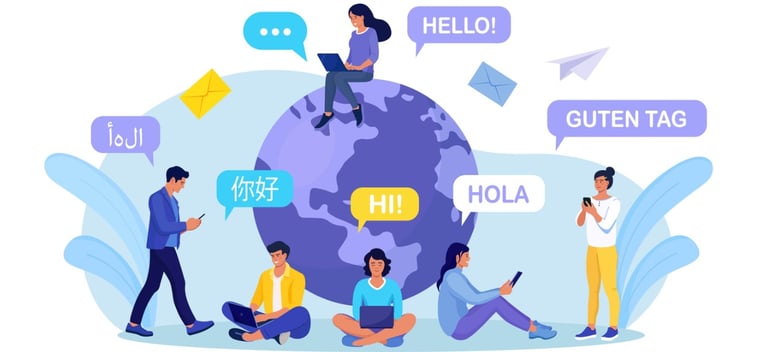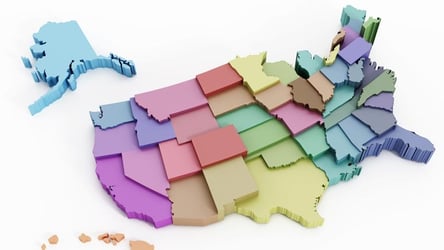Top 5 Languages to Translate Your Website Into for Global Growth

Every company looking to reach audiences in new locations—or make their content more accessible in areas they're already established—should consider website translation.
But should you be translating into any language, at random? Of course not.
At LinguaLinx, we understand the value of translating and localizing websites firsthand from helping countless organizations translate their sites for greater global impact. We also know that website translation works best when it’s targeted and intentional.
Below, we’ll establish the biggest factors to consider when picking website translation languages, then run through six tongues you should be prioritizing—and why!
But first, we should talk about…
The Elephant in the Room: English Language Website Translation
By far, the most common target for website translation is English.
English is used by the highest percentage of internet users (25.9%) and commands the highest usage of all websites with a known language on the world wide web (59.5%).
However, given the context in which you’re reading this page, you’re likely looking to translate your website from English into one or more target languages. That’s because, even though English is the most prominent language used online, it’s critical to reach audiences in their native tongues through translation and localization to engage them.
Factors to Consider When Choosing a Translation Language
The figures above capture how prevalent English is across the web, but they can be misleading. English predominance online is less reflective of peoples’ desires than of the general cultural influence of English-speaking parts of the world, such as the US and the UK.
Given a choice, shoppers and all other web denizens prefer to engage with websites in their own languages. That applies both to countries and regions where English is less dominant and those—US and UK included—where a plethora of languages are spoken.
If you’re looking to translate your website to reach these audiences, you'll want to ensure you choose a quality language service provider. You need to think about things like how many people speak a given language, natively, and where.
Targeting Readers' Mother Tongues (First or Native Languages)
There are about 8 billion people in the world at present. Of that figure, the CIA estimates that approximately 16.5% speak English. The other most prominent languages include:
- Mandarin Chinese — (14.6%)
- Hindi — (8.3%)
- Spanish — (7%)
- French —(3.6%)
- Arabic – (3.6%)
However, upon closer examination, it’s also important to consider which languages are people’s first. Again according to CIA estimates, select figures break down as follows:
- Mandarin Chinese first – 12.3%
- Spanish first —6%
- English first — 5.1%
- Arabic first — 5.1%
- Hindi first —3.5%
One takeaway is that languages with a small gap between the percentage of speakers and native speakers (Spanish, Chinese) are worth prioritizing. Another is just how many English speakers would likely benefit from reading your website in their mother tongue!
Official Languages and Country / Regional Business Expansion
Aside from considering how many potential new readers you can reach, it’s also worth thinking about where you’ll reach them. Global spread and concentration are especially important if you’re considering a launch within a region rich with linguistic diversity.
Consider the number of countries a language is spoken or official in. For example:
- French is spoken in 46 countries and an official language in 39 countries
- Spanish is spoken in 34 countries and an official language in 21 countries
Despite being spoken and official in far more countries, French has significantly fewer native speakers (97 million) than Spanish (457 million), according to this data set.
Does that mean one or the other is better to translate your website into? It depends.
If you’re targeting a broader global appeal across specific populations in any country, a language like French might be preferable. If you’re instead targeting a specific region (say, South America), then it might make more sense to target a language like Spanish.
The 5 Best Languages to Translate Your Website Into
Without further ado, let’s put all of the considerations above into action and determine the best languages you should target for your website translation project.
Website Translation Target #1: Chinese (Mandarin)
Chinese languages (especially Mandarin) should be among the first you consider when translating your website. Despite being an official language in just five countries, it’s spoken natively by the most people worldwide (1.35 billion), across 25 countries.
Specifically, about 955 million Chinese speakers speak Mandarin, with several other dialects native to particular regions being spoken by up to 80 million people each.
Chinese speakers are spread across the world. But if you want to expand into China properly, you’ll almost certainly need to translate your website into one or more Chinese languages. About 92% of the population in China, along with 92% in Hong Kong and 8.5% in Taiwan (not to mention over 50% of Singaporeans) speak Chinese natively.
Website Translation Target #2: Spanish
The reasons for targeting Spanish as a website translation language are like those for Chinese, despite the tongues themselves being as similar as apples and oranges.
Namely: Spanish is spoken natively by 457 million people across the world, concentrated mostly in 34 countries, 21 of which it is an official language thereof. However, its usage concentration is highest not in Spain (74%) but throughout Central and South America:
- Cuba (100%)
- Columbia (99%)
- El Salvador (99%)
- Dominican Republic (98%)
- Costa Rica (97.5%)
- Honduras (97.2%)
- Venezuela (96.9%)
- Argentina (96.8%)
- Uruguay (95.7%)
- Nicaragua (95.3%)
- Ecuador (93%)
It’s about access—to a region, not one specific country. Translating your website into Spanish will pay dividends in many countries across the world. But, simply put, if you plan on doing business in Latin America, you should have a Spanish-language website.
Website Translation Target #3: Arabic
To a slightly lesser extent, Arabic is to the Middle East and North Africa (MENA) region what Spanish is to Latin America. Fewer people worldwide speak Arabic natively (360 million), but its distribution mirrors Spanish’s uncannily—spoken in 33 countries, official in 22.
As such, the reasons for targeting Arabic are similar to those for targeting Spanish.
For example: your website will have an easier time attracting readers in Egypt, where 98.8% of the people speak Arabic, if you’ve translated and localized accordingly.
A common misconception is that Arabic is exclusively spoken by people who practice Islam. It is the language of the Quran, but the vast majority of Muslims do not speak Arabic natively. Instead, a better way to think of this global language is a shared tongue across countries where many languages are spoken. In this way, it is closely related to…
Website Translation Target #4: French
The term lingua franca may sound like it’s related to the French language, but that is only (partially) a coincidence. Nonetheless, French is one of the lingua francas, or world languages, despite being spoken by relatively few people compared to others on this list.
Namely, French is spoken by about 97 million people natively worldwide, and it sports a distribution of 80% or higher in only three countries—France (93.6%), Martinique (80%), and Saint Barthelemy (80%). Despite this, about 300 million people speak French worldwide.
As noted above, the appeal of French as a website translation language is actually about widespread global reach rather than a concentrated impact on any particular region.
Website Translation Target #5: Hindi
Hindi, the national language of just one country (India), is one of the most commonly spoken tongues in the world. Per one estimate, Hindi sits second to Chinese with 572 million native speakers, due in part to India’s population being among the largest in the world.
For this reason alone, it’s worth considering for any website translation project.
However, nuances in the distribution of the language, both on the Indian subcontinent and elsewhere, are what make it less attractive than some others above. Consider that:
- Hindi is only considered to be spoken natively in eight countries worldwide
- Its highest distributions in Fiji (43.7%) and India (41%) do not exceed 50%.
- In other parts of Africa, Asia, and the Caribbean, distribution is below 5%.
Put another way, Hindi does not offer the same guarantee of reach across the regions in which it is most commonly spoken that languages like Chinese or Spanish do. If you plan to expand into India, you’ll want to translate your website into Hindi! But it won’t be anything like a one-size-fits-all solution. You’ll need several other tongues, as well.
Get a Quote for Your Website Translation Project
Translating your website into different languages is a smart move to grow your global reach and make your audience's experience better. It's not just about changing words; it's about connecting with people in a way that feels right for their culture.
Book a free consultation with us at LinguaLinx to talk about your website translation needs. We're experts in not just translating, but also making sure your content fits well with different cultures. Our team knows how to make your website speak to your customers in their language.
With LinguaLinx, you can trust that we'll handle your website translation carefully. We hold ISO 17100 and ISO 9001 certifications, which means our work meets very high standards.
Contact us today to learn how we can help make your website work worldwide. With LinguaLinx, you can be sure that your message will be clear and effective, no matter the language.






